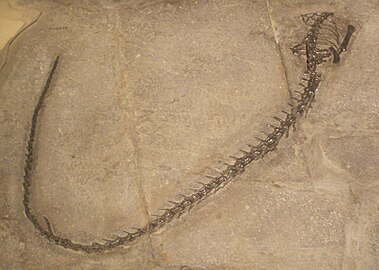
Chroniosuchidae is a family of semi-aquatic tetrapods found in sediments from the upper Permian and the upper Triassic periods, most in Russia. They were generally rather large animals, with long jaws similar to those found in modern crocodiles, and probably lived a similar lifestyle as riverside piscivores and ambush predators. Like all chroniosuchians, they bore extensive osteoderm armour on their backs, possibly as protection against terrestrial predators such as the Permian therapsids and the Triassic rauisuchians.
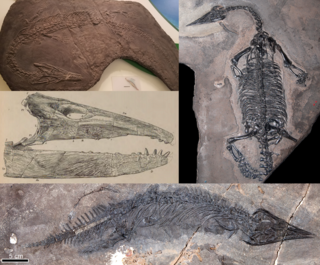
Thalattosauria is an extinct order of marine reptiles that lived in the Middle to Late Triassic. Thalattosaurs were diverse in size and shape, and are divided into two superfamilies: Askeptosauroidea and Thalattosauroidea. Askeptosauroids were endemic to the Tethys Ocean, their fossils have been found in Europe and China, and they were likely semiaquatic fish eaters with straight snouts and decent terrestrial abilities. Thalattosauroids were more specialized for aquatic life and most had unusual downturned snouts and crushing dentition. Thalattosauroids lived along the coasts of both Panthalassa and the Tethys Ocean, and were most diverse in China and western North America. The largest species of thalattosaurs grew to over 4 meters (13 feet) in length, including a long, flattened tail utilized in underwater propulsion. Although thalattosaurs bore a superficial resemblance to lizards, their exact relationships are unresolved. They are widely accepted as diapsids, but experts have variously placed them on the reptile family tree among Lepidosauromorpha, Archosauromorpha, ichthyosaurs, and/or other marine reptiles.

Eodicynodon is an extinct genus of dicynodont therapsids, a highly diverse group of herbivorous synapsids that were widespread during the middle-late Permian and early Triassic. As its name suggests, Eodicynodon is the oldest and most primitive dicynodont yet identified, ranging from the middle to late Permian and possessing a mix of ancestral Anomodont/therapsid features and derived dicynodont synapomorphies.

Dicellopyge is an extinct genus of freshwater ray-finned fish that lived during the Anisian age of the Middle Triassic epoch in what is now South Africa. It was originally named "Dicellopygae" by James Brough but the name was later corrected to Dicellopyge by Peter Hutchinson.
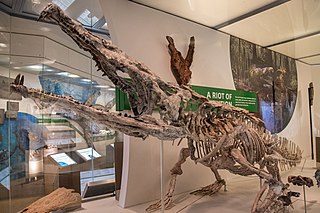
Smilosuchus is an extinct genus of leptosuchomorph parasuchid from the Late Triassic of North America.

Clevosaurus is an extinct genus of rhynchocephalian reptile from the Late Triassic and the Early Jurassic periods. Species of Clevosaurus were widespread across Pangaea, and have been found on all continents except Australia and Antarctica. Five species of Clevosaurus have been found in ancient fissure fill deposits in south-west England and Wales, alongside other sphenodontians, early mammals and dinosaurs. In regards to its Pangaean distribution, C. hadroprodon is the oldest record of a sphenodontian from Gondwana, though its affinity to Clevosaurus has been questioned.

Paleontology or palaeontology is the study of prehistoric life forms on Earth through the examination of plant and animal fossils. This includes the study of body fossils, tracks (ichnites), burrows, cast-off parts, fossilised feces (coprolites), palynomorphs and chemical residues. Because humans have encountered fossils for millennia, paleontology has a long history both before and after becoming formalized as a science. This article records significant discoveries and events related to paleontology that occurred or were published in the year 2009.

Lystrosauridae is a family of dicynodont therapsids from the Permian and Triassic time periods. It includes two genera, Lystrosaurus and Kwazulusaurus. Kwazulusaurus includes a single species, K. shakai, from the Late Permian of South Africa and Lystrosaurus includes many species from the Late Permian and Early Triassic of South Africa, India, and Antarctica.
Tricuspisaurus is an extinct genus of reptile originally described as a trilophosaurid; it was later considered likely to be a procolophonid, but recent analyses have affirmed the original classification. Fossils are known from the Ruthin Quarry in Glamorgan, Wales, one of several Late Triassic to Early Jurassic British fissure deposits. Like some trilophosaurs, it has an edentulous, or toothless beak. Tricuspisaurus gets its name from its heterodont dentition, which includes tricuspid teeth, or teeth with three cusps. The type species, T. thomasi, was named in 1957 along with the possible trilophosaur Variodens inopinatus from Somerset, England.
Uruyiella is an extinct genus of laidleriid temnospondyl from Late Triassic Buena Vista Formation of Uruguay. It was first named by Graciela Piñeiro, Claudia Marsicano and Nora Lorenzo in 2007, from a nearly complete skull. The type species is Uruyiella liminea and it is the only close relative of the enigmatic Early Triassic Laidleria.
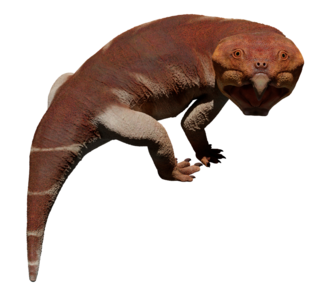
Hyperodapedontinae is a subfamily of rhynchosaurs within the family Rhynchosauridae. Fossils have been found from Argentina, Brazil, Canada, India, Madagascar, Scotland, Tanzania, United States and Zimbabwe.
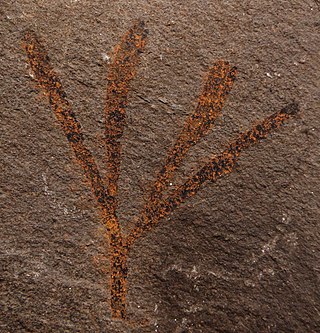
Sphenobaiera is a form genus for plant leaves belonging to the order Ginkgoales found in rocks from Triassic to Cretaceous periods. The genus Sphenobaiera is used for plants with wedge-shaped leaves that can be distinguished from Ginkgo, Ginkgoites and Baiera by the lack of a petiole. It became extinct about 72.6 million years ago. The family to which this genus belongs has not been conclusively established; an affinity with the Karkeniaceae has been suggested on morphological grounds.

Kapes is an extinct genus of procolophonid parareptile from the Lower and Middle Triassic of the United Kingdom and Russia. The type species K. amaenus was named in 1975 from the banks of the Vychegda River in the Komi Republic of Russia. In 1983, a new species was brought into the genus, K. majmesculae. K. majmesculae was first named in 1968 as a member of the genus Tichvinskia. A third Russian species, K. serotinus, was named in 1991. In 2002, Kapes bentoni was described from the Middle Triassic Otter Sandstone Formation of Devon, England, extending the geographic range of Kapes. In the same paper, K. serotinus was synonymized with K. majmesculae and another Russian species was assigned to Kapes called K. komiensis. K. komiensis was first named in 1975 as a member of the genus Macrophon.

Urumchia is an extinct genus of therocephalian therapsids from the Early Triassic of China. The type species Urumchia lii was described by Chinese paleontologist C. C. Young in 1952 from the Jiucaiyuan Formation in Xinjiang. The holotype skull has been lost, but Young was able to describe the species on the basis of a detailed cast of the skull. Urumchia is similar to the South African therocephalian Regisaurus in having an expanded pair of vomer bones on the underside of the skull that form a secondary palate. In Urumchia the front end of the vomers narrow to a point, while in Regisaurus they do not. Urumchia has six incisors on either side of the upper jaw, a primitive condition among baurioid therocephalians that usually have fewer incisors.
Platycrossos is an extinct genus of protocoleopteran beetles in the family Permosynidae. It is known from the Triassic and Jurassic of Australia, Austria, Mongolia and Russia. Like other members of the family, the species of this genus were described from fossils of isolated elytra with punctate striae.
Capulomala is an extinct genus of stereospondyl temnospondyl known from the Early Triassic. Separate species are recognised, C. panchetensis found in the Panchet Formation of India and C. arcadiaensis from the Arcadia Formation of Australia.
Barracudasaurus is a dubious genus of ichthyosaur from the Triassic of China, containing the single species B. maotaiensis.
Coartaredens is an extinct genus of reptile from the Middle Triassic of England. It contains a single species, Coartaredens isaaci, from the Anisian-age Otter Sandstone of Devon. The species is based on a partial jaw and other fragments with large conical teeth. Though originally described as a lepidosauromorph, some authors have instead considered it to be a procolophonid.
Nilssoniopteris is an extinct form genus of leaves belonging to the Bennettitales. Leaves are slender and often entire-margined (smooth-edged), though some species have dissected leaves with numerous small segments extending down to the rachis of the leaf. Nilssoniopteris-like leaves are distinguished by their syndetocheilic stomata, indicating bennettitalean affinities. Similar "taeniopterid" leaves are placed in the genus Nilssonia if their stomata are instead haplocheilic, or Taeniopteris if the cuticle is not preserved. Leaves of Nilssoniopteris vittata from the Middle Jurassic of England are associated with bisexual Williamsoniella reproductive structures.
Pelourdea is an extinct genus of conifer. Species belonging to the genus lived from the Triassic to the Middle Jurassic and have been found in Europe and North America.

